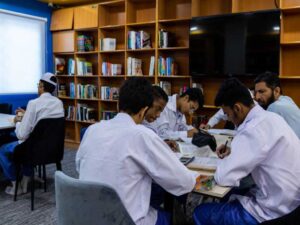O/A Level Section
The Senior Section at The Benchmark marks an important transition into higher learning, responsibility, and personal growth. This stage prepares students not only for academic excellence but also for life beyond school — guided by the principles of faith, integrity, and perseverance.
Our gender-segregated campuses provide an environment where both boys and girls can thrive with confidence, modesty, and focus. Separate settings ensure that teaching methods and mentorship are tailored to meet their specific needs while upholding the values of respect and Islamic etiquette.
At this level, students are encouraged to take greater ownership of their learning journey. Through interactive discussions, projects, and independent exploration, they develop essential skills such as critical thinking, discipline, and leadership — all while remaining grounded in Islamic morals and humility.
Highlights of Our Senior Section
Senior Levels
Embark on a journey, mastering subjects from science to languages. Develop critical thinking and global awareness, opening doors to top universities worldwide.
BOOKS
Cambridge O levels English Language 2nd Edition
by John Reynolds and Patricia Acres
Paper-I 2 hours, 50 Marks – Reading
Question 1 Comprehension task
– Demonstrate understanding of explicit and implicit meanings and attitude.
Question 2 Use of Language task
– Demonstrate understanding of how writers achieve effects and influence readers.
Question 3a Summary task
– Summary as continuous writing of no more than 150 words
Question 3b Short response task
– Short response to show understanding of implicit meanings and attitude in response to Text B
Paper-II 2 hours, 50 Marks – Writing
Directed Writing
– Read one or two texts totaling approximately 400–450 words in length.
– Use, develop and evaluate the information in the text(s) to create a discursive/argumentative/ persuasive speech, email, report, letter or article.
Composition
– Descriptive / Narrative
BOOKS
Think New Syllabus Mathematics 8th Edition Text Book 1,2,3,4
PAPER I – 2 hours, 100 marks
PAPER II – 2 hours,100 marks
1 Number
2 Algebra and graphs
3 Coordinate geometry
4 Geometry
5 Mensuration
6 Trigonometry
7 Transformations and vectors
8 Probability
9 Statistics
BOOKS
Chemistry for Cambridge O levels student book
by DEREK MC MONAGLE
PAPER I 1 hour, 40 marks
PAPER II 1 hour 45 minutes 80 marks
1 States of matter
2 Atoms, elements and compounds
3 Stoichiometry
4 Electrochemistry
5 Chemical energetics
6 Chemical reactions
7 Acids, bases and salts
8 The Periodic Table
9 Metals
10 Chemistry of the environment
11 Organic chemistry
12 Experimental techniques and chemical analysis
PAPER 4 – ATP 1 hour 40 marks
BOOKS
Cambridge O levels Physics by Heather Kennett, Tom Duncan
PAPER I 1 hour, 40 marks
PAPER II 1 hour 45 minutes 80 marks
1 Motion, forces and energy
2 Thermal Physics
3 Waves
4 Electricity and Magnetism
5 Nuclear Physics
6 Space Physics
PAPER 4 – ATP 1 hour 40 marks
BOOKS
Biology for Cambridge O levels Third Edition by Phil Bradfield
PAPER I 1 hour, 40 marks
PAPER II 1 hour 45 minutes 80 marks
1 Cells
2 Classification
3 Movement into and out of cells
4 Biological molecules
5 Enzymes
6 Plant nutrition
7 Transport in flowering plants
8 Human nutrition
9 Human gas exchange
10 Respiration
11 Transport in humans
12 Disease and immunity
13 Excretion
14 Coordination and control
15 Coordination and response in plants
16 Development of organisms and continuity of life
17 Inheritance
18 Biotechnology and genetic modification
19 Relationships of organisms with one another and with the environment
PAPER 4 – ATP – 1 hour 40 marks
BOOKS
Cambridge IGCSE and O Level Computer Science Second Edition by David Watson and Helen Williams D
PAPER I 1 hour 45 minutes 75 marks
Computer Systems
1 Data representation
2 Data transmission
3 Hardware
4 Software
5 The internet and its uses
6 Automated and emerging technologies
PAPER II 1 hour 45 minutes 75 marks
Algorithms, Programming and Logic
7 Algorithm design and problem-solving
8 Programming
9 Databases
10 Boolean logic
BOOKS
O level Islamiyat by Hammad Ibne Nishad Text Book Paper I, II
PAPER I 1½ hours
1. Major themes of the Qur’an Three groups of passages are set for close study. These relate to the themes of: • God in himself • God’s relationship with the created world • God’s Messengers.
2. The history and importance of the Qur’an the revelation of the Qur’an to the Prophet (pbuh) between the years 610 and 632 • the account of the compilation of the Qur’an under the Rightly Guided Caliphs • the major themes of the Qur’an as contained both in the passages set for special study and in other similar passages • the use of the Qur’an in legal thinking, and its relationship with the Hadiths, consensus (ijma‘) and analogy (qiyas) • its significance as the basis of all thought and action in Islam.
3. The life and importance of the Prophet Muhammad (pbuh) Candidates should study: • the main events of the Prophet’s life from his birth to his call to prophethood • the main events of his activities in Makka and his experiences with his opponents • the main events of his activities in Madina, his leadership of the community there and his conflicts with the Makkans and others • his actions and character • the importance of his actions as examples for Muslim individuals in their personal conduct and relations with others including women and non-Muslims • the importance of his actions as examples for Muslim communities in their relations with other states • his significance as Seal of the Prophets and last Messenger of God. Candidates should be able to give accounts of the main events of the Prophet’s life, and his significance in Muslim beliefs. They should also be able to explain the importance of his actions and experiences in the history and beliefs of Islam, particularly in the way they provide examples for present day Muslim individuals and communities. In the examination, there will be either one or two questions on this topic.
4. The first Islamic community Candidates should study: • the Prophet’s wives • his descendants, including his children, grandchildren and the direct line recognised among Shi‘a Muslims as Imams • his leading Companions, including the Ten Blessed Companions, his Scribes, the major characters who surrounded him in his ministry, the Emigrants and Helpers, and the four Rightly Guided Caliphs during his lifetime. (Note that the period of the Rightly Guided Caliphs’ rules after the time of the Prophet (pbuh) is included in the syllabus under Paper 2.)
PAPER II 1½ hours
1. Major teachings in the Hadiths of the Prophet Two groups of passages are set for close study. These relate to: • individual conduct • life in the community.
2. The history and importance of the Hadiths Candidates should study: • the history of the compilation of the Hadiths • the earliest collections • the main musnad and musannaf collections • the main compilers and their activities • the methods based on examination of the chain of transmitters (isnad) and the text (matn) of a Hadith to test the reliability of the Hadith • the main features of the six collections of Sunni Hadiths and the four collections of Shi‘a Hadiths • the major themes of the Hadiths as these are contained both in the passages set for special study and in other similar passages • their use in legal thinking, and their relationship with the Qur’an, consensus (ijma‘) and analogy (qiyas) • their significance in thought and action in Islam
3. The period of rule of the Rightly Guided Caliphs and their importance as leaders Candidates should study: • the main events of the rules of the four Caliphs • their policies in maintaining and expanding the state • their approaches to leading the community • their main achievements • the main difficulties they encountered • their significance as examples of leadership • the importance of their rules as models for government today • their importance as examples for Muslim communities in their relations with other states. (Note that the lives and activities of the Caliphs during the Prophet’s lifetime are included in the syllabus under Paper 1.)
4. The Articles of Faith and the Pillars of Islam Candidates should study: • the Six Articles of Faith: – God, including what Muslims believe about him – angels, their nature and duties – books, their contents and purpose – prophets, their character and function – God’s predestination and decree, its meaning and significance – Resurrection and the last day, the main events and its significance. • Jihad in its range of meanings, physical, mental and spiritual. • the Five Pillars of Islam: – the declaration of faith, shahada, including the significance of what it contains – prayer, salat, including preparations, its performance and importance, congregational prayers on Fridays and festivals, times of prayer, the place of prayer, private prayer, delayed prayer – alms-giving, zakat, how it is performed and its significance in the community – fasting, sawm, including the way it is observed, its significance and those exempted – pilgrimage, hajj, including the main observances involved and their significance.4.
BOOKS
The Environment of Pakistan by Huma Naz Sethi 7th Edition
History: Pakistan History, Culture and Government by Nigel Smith – Updated Edition
PAPER I 1½ hours The History And Culture Of Pakistan
1. Cultural and historical background to the Pakistan Movement
– the religious reforms of Shah Waliullah and his role in the political and religious context of the time
– Syed Ahmad Barelvi and the revival of Islam in the subcontinent
– the Jihad movement and the Mujahideen
– Haji Shariatullah and the Faraizi Movement.
– Internal Indian reasons for the decline of the Mughal Empire: • the impact of Aurangzeb’s policies on the stability of the Mughal Empire • the effectiveness of his successors as rulers • problems of controlling the Empire • the rise of the Maratha and Sikh empires. External reasons for the decline of the Mughal Empire: • foreign invasions from Persia and Afghanistan • the East India Company’s involvement in the subcontinent • British relations with the later Mughal rulers of Delhi • British expansion from the 1750s to the 1850s in the subcontinent • a general overview of the course of, and reasons for, British annexation of the territories which now encompass Pakistan (including the Anglo–Sikh wars and the annexations of Lahore, the Punjab and Peshawar) • the British search for a ‘natural’ and ‘scientific’ NW Frontier • British policy towards Tribal Territory, War of independence 1857
2. The emergence of Pakistan 1906–47
3. Nationhood 1947–99
PAPER II 1½ hours The Environment Of Pakistan
1.The land of Pakistan
(a) Location of Pakistan
(b) Location of administrative areas and cities
(c) The natural topography, including drainage
(d) Climate
2. Natural resources – an issue of sustainability
(a) Water
(b) Forests
(c) Mineral resources
(d) Fish
3. Power
(a) Sources
(b) Non-renewables
(c) Renewables
4. Agricultural development
(a) Agricultural systems
(b) Crops and livestock
(c) Factors affecting production
5. Industrial development
(a) Understanding common terms
(b) Secondary and tertiary industries
6. Trade
(a) Major exports and imports
(b) Pakistan’s trading partners
7. Transport and telecommunications
(a) Internal transport
(b) International transport
(c) Telecommunications
8. Population and employment
(a) Structure and growth
(b) Movements of population
(c) Distribution and density of population
(d) Employment
BOOKS
Kawish e Jadeed Urdu Paper I and 2 by Ghulam Waris Iqbal
PAPER I 1 hour 45 minutes
Reading and Writing 50 marks
Exercise 1 – Short-answer questions: candidates read a short text printed in the question paper and answer a series of questions that test their skimming and gist-reading skills and require short answers of a single word or phrase. The text will be one of the following types: advertisement, brochure, leaflet, guide, report, manual, instructions, and newspaper/magazine article.
Exercise 2 – Multiple matching: candidates read a series of short paragraphs followed by a series of sentences, then match each sentence to one of the paragraphs.
Exercise 3 – Note-making: candidates read a longer text printed in the question paper and make brief notes under a number of supplied headings.
Exercise 4 – Summary: candidates write a paragraph-length summary (of no more than 100 words) about an aspect or aspects of the text in Exercise 3. Candidates should use their own words as far as possible.
Exercise 5 – Writing exercise: candidates write a short piece of functional prose such as an email, of approximately 150 words. A stimulus of short prompts and/or pictures will be printed in the question paper. A purpose, format and audience for the writing will be specified.
PAPER II 1 hour 30 minutes
Grammar, Writing and Translation 50 marks
Exercise 1 – Sentence transformation: candidates read five short sentences and transform the sentences using given prompts, without changing their original meaning.
Exercise 2 – Multiple-choice cloze passage: candidates read a short text with gaps to be filled from multiple-choice options. This exercise tests the application of grammatical usage in context, such as conjugation of verbs, subject/verb agreement, comparatives, superlatives, parts of speech, nouns, prepositions, post positions, articles and vocabulary appropriate to the context.
Exercise 3 – Extended writing exercise: candidates write a piece of continuous prose of approximately 200 words. A stimulus of short prompts will be printed in the question paper. A purpose, format and audience for the writing will be specified.
Exercise 4 – Translation: candidates translate a short passage of approximately 150 words from English into Urdu.
Paper – I Multiple Choice Questions
1 hour 15 min, 40 Marks
40 Multiple-choice questions
Questions are based on the AS Level syllabus content.
Externally assessed.
31% of the AS Level
15.5% of the A Level.
Paper – II AS Level Structured Level Questions
1 hour 15 min, 60 Marks
Structured questions
Questions are based on the AS Level syllabus content.
Externally assessed.
46% of the AS Level
15.5% of the A Level.
Paper – III Advanced Practical Skills
1 hour 15 min, 40 Marks
Practical Work & structured questions.
Questions are based on the experimental skills in the Practical assessment section of the syllabus.
The content of the questions may be outside the syllabus content.
Externally assessed.
23% of the AS Level
11.5% of the A Level.
Paper – IV Planning Analysis & Evaluation
1 hour 15 min, 30 Marks
Candidates answer two compulsory questions.
Questions are based on the experimental skills in the Practical assessment section of the syllabus.
The context of the questions may be outside the syllabus content.
Externally assessed.
11.5% of the AS Level.
PAPER – I AS Level Multiple Choice
1 hour, 30 marks
30 Multiple Choice Questions.
Questions are based on the AS Level subject content.
Externally assessed.
33% of the AS Level
17% of the A Level.
PAPER – II AS Level Data Response and Essays
1 hour, 60 marks
Section A: one data response question (20 marks)
Section B: one essay from a choice of two focusing mainly on microeconomics; there are two parts of each essay question (20 marks)
Section C: one essay from a choice of two focusing mainly on macroeconomics; there are two parts of each essay questions (20 marks)
Questions are based on AS level subject content.
Externally assessed.
67% of the AS Level.
33% of the A Level.
PAPER – III A Level Multiple Choice
1 hour 15 min, 30 marks
30 Multiple Choice Question.
Questions are based on the A Level subject content; knowledge of material from the AS Level subject content is assumed.
Externally assessed.
17% of the A Level.
PAPER – IV A Level Data Response and Essays
2 hours, 60 marks
Section A: one data response question (20 marks)
Section B: one essay from a choice of two focusing mainly on microeconomics: the essay questions are unstructured with no parts (20 marks)
Section C: one essay from a choice of two focusing on mainly on macroeconomics; the essay questions are unstructured with no parts (20 marks)
Questions are based on the A Level subject content; knowledge of material from the AS Level subject content is assumed.
Externally assessed.
33% of the A Level.
PAPER I Multiple Choice
1 hour, 30 marks
30 Multiple Choice Questions.
Questions are based on section 1 and 2 of the subject content.
Externally assessed.
28% of the AS Level.
14% of the A Level.
PAPER II Fundamentals of Accounting
1 hour 45 minutes, 90 marks
1 States of matter
2 Atoms, elements and compounds
3 Stoichiometry
4 Electrochemistry
5 Chemical energetics
6 Chemical reactions
7 Acids, bases and salts
8 The Periodic Table
9 Metals
10 Chemistry of the environmen
11 Organic chemistry
12 Experimental techniques and chemical analysis
PAPER III – Financial Accounting
1 hour 30 mins, 75 marks
Three structured questions.
Questions are based on section 3 of the subject content; knowledge of material from the AS Level subject content is assumed.
Externally assessed.
30% of the AS Level.
Paper IV – Cost and Management Accounting
1 hour, 50 marks
Two structured questions.
Questions are based on section 4 of the subject content; knowledge of material from the AS Level subject content is assumed.
Externally assessed.
20% of the A Level
PURE MATHEMATICS COMPONENT
Paper – I Pure Mathematics 1
1 hour 50 mins, 75 marks
10 to 12 structured questions based on the Pure Mathematics I subject content.
Written Examination.
Externally assessed.
60% of the AS Level
30% of the A Level
Compulsory for the AS Level and A Level.
Paper – II Pure Mathematics 3 1 hour 50 min, 75 marks
9 to 11 structured questions based on the Pure Mathematics 3 subject content.
Written Examination.
Externally assessed.
30% of the A Level only.
Compulsory for A Level.
PROBABLITY & STATISTICS COMPONENTS
Paper – V Probability & Statistics I
1 hour 15 min, 50 marks
6 to 8 structured questions based on Probability & Statistics I subject content.
Written Examination
Externally assessed.
40% of the AS Level
20% of the A Level
Compulsory for A Level
Paper – VI Probability & Statistics II
1 hour 15 min, 50 marks
6 to 8 structured questions based on Probability & Statistics II subject content.
Written Examination
Externally assessed.
20% of the A Level
Offered only as part of A Level.
PAPER – I Multiple Choice
1 hour 15 min, 40 marks
40 multiple choice questions.
Questions are based on AS level syllabus content.
Externally assessed.
31% of the AS Level.
15.5% of the A Level.
PAPER – II AS Level Structured Questions
1 hour 15 min, 60 marks
Structured Questions
Questions are based on the AS Level syllabus content.
Externally assessed.
46% of the AS Level
23% of the A Level.
PAPER – III Advanced Practical Skills
2 hours, 40 marks
Practical Works & Structured Questions.
Questions are based on experimental skills in the Practical Assessment section of the syllabus.
Externally assessed.
23% of the AS Level
11.5% of the A Level.
PAPER – IV A Level Structured Questions
2 hours, 100 marks
Structured Questions.
Questions are based on A Level Syllabus content; knowledge of material from the AS Level syllabus content will be required..
Externally assessed.
38.5% of the A Level
Paper – V Planning, Analysis, & Evaluation
2 hours, 100 marks
Questions are based on the experimental skills of planning, analysis, and evaluation.
The context of the question may be outside the syllabus content.
Externally assessed.
11.5% of the A Level.
Campus Location
The Benchmark O&A Level Campus (For Boys)
Address: D193, Block 7 Gulshan-e-Iqbal, Karachi, Pakistan
The Benchmark Main Campus (For Girls)
Address: E 82, Block 4 Gulshan-e-Iqbal, Karachi, 75300, Pakistan
School Timings
(Monday – Thursday)
Friday





